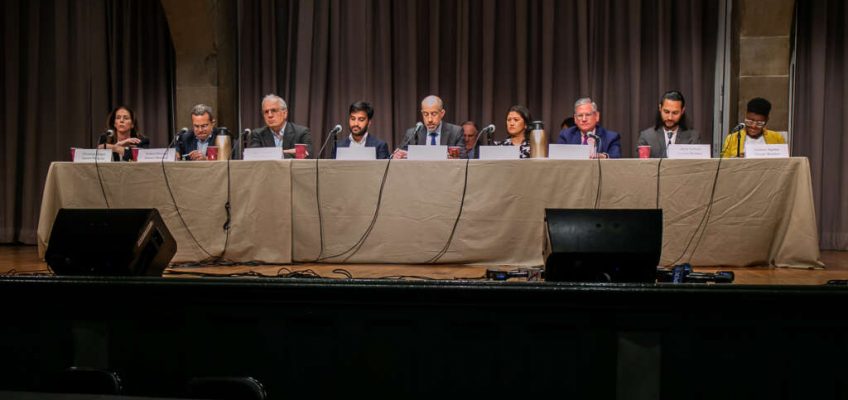“It’s time for the Adams Administration to acknowledge that recognizing the problem is just the beginning; meaningful reforms must follow—ones that not only uphold the law but also protect religious freedom and honor the dignity of every New Yorker.”
Benjamin Kanter/Mayoral Photo Office.
This past February, Mayor Eric Adams and the New York City Police Department (NYPD) took to their social media accounts to “celebrate” World Hijab Day—a day dedicated to honoring, promoting understanding, and showing solidarity with Muslim women who wear the hijab.
This show of support rings hollow when contrasted with the NYPD’s increasing use of a disturbing tactic at protests: forcibly removing women’s hijabs as a brutal form of crowd control and intimidation.
Last month, Emery Celli Brinckerhoff Abady Ward & Maazel LLP (ECBAWM) filed a lawsuit on behalf of two hijabi protestors, Zarmeen Azam and Shajnin Howlader, who were assaulted, including being strangled, and had their hijabs forcefully removed by NYPD officers while peacefully protesting.
The Council on American-Islamic Relations New York joined the lawsuit as an organizational plaintiff because the NYPD’s practice of forcibly removing protestors’ hijabs directly undermines our mission to protect civil rights, promote justice, and empower Muslims.
This alarming behavior not only interferes with our efforts to support hate crime victims—who are deterred from seeking justice when they fear the police—but also hinders our work to empower Muslims to exercise their First Amendment rights and defend religious liberty. When the NYPD suppresses these fundamental rights, it weakens our ability to advocate for New York’s Muslim community.
Forcing someone to remove a hijab—a headscarf that covers the hair, ears, neck, and parts of the chest—in public, particularly in the presence of men who are not immediate family, is a profound violation of their deeply held religious beliefs. This act not only assaults the wearer’s faith and dignity but also infringes upon their constitutional rights, including free speech, religious freedom, and bodily integrity.
Both Ms. Howlader and Ms. Azam, who wear the hijab as a central part of their faith, were subjected to this violation in a manner no New Yorker should ever endure.
At a protest last August calling attention to the genocide in Palestine, NYPD officers shoved, grabbed, pepper-sprayed, and violently choked Ms. Howlader with her hijab. Her desperate cries for help, including repeatedly shouting “I can’t breathe,” were callously ignored by the police. The physical and emotional toll of that traumatic experience continues to haunt her, manifesting in flashbacks, sleep loss, and a fear of crowds.
Ms. Azam was choked by an NYPD officer, who strangled her with one hand while striking at protestors with a baton in his other hand. She was then dragged through the crowd, had her shirt lifted up repeatedly while being arrested, and denied the opportunity to adjust her hijab when placed in a cell. The emotional trauma of having her dignity stripped away in front of strangers was compounded by the fact that other officers stood by without intervening.
Ms. Howlader and Ms. Azam demand justice—not just for themselves, but for all hijabi women who have endured similar acts of violence and humiliation.
Since last summer, CAIR-NY has received numerous complaints from women who reported that NYPD officers aggressively ripped off their hijabs during protests. At least five other women have shared experiences with CAIR-NY from incidents in June, July, August, and September, where officers at protests violently and publicly removed their hijabs.
This is not the first time the NYPD has faced criticism over its handling of religious head coverings.
In 2018, ECBAWM filed a class action lawsuit against the city challenging the NYPD’s practice of forcing individuals to remove their religious head coverings, including hijabs, for post-arrest photos. The lawsuit argued that this practice violated the constitutional rights of individuals to freely practice their religion.
The lawsuit settled last year, and as part of the settlement, which included $17.5 million in damages for class members, the NYPD revised its policies regarding the removal of religious head coverings. The revised policy ensures that such coverings will only be removed for booking photos under specific, narrowly defined circumstances, safeguarding individuals’ right to religious expression.
But there is still much work to be done.
NYPD personnel must never be permitted to forcibly or publicly remove women’s hijabs. While City Hall and the NYPD may continue to post their support for Muslim women and the hijab on social media, actions speak far louder than tweets.
It’s time for the Adams Administration to acknowledge that recognizing the problem is just the beginning; meaningful reforms must follow—ones that not only uphold the law but also protect religious freedom and honor the dignity of every New Yorker.
Christina John is a staff attorney with the legal team at the Council on American-Islamic Relations New York
The post Opinion: The NYPD’s Troubling Practice of Removing Women’s Hijabs at Protests appeared first on City Limits.



